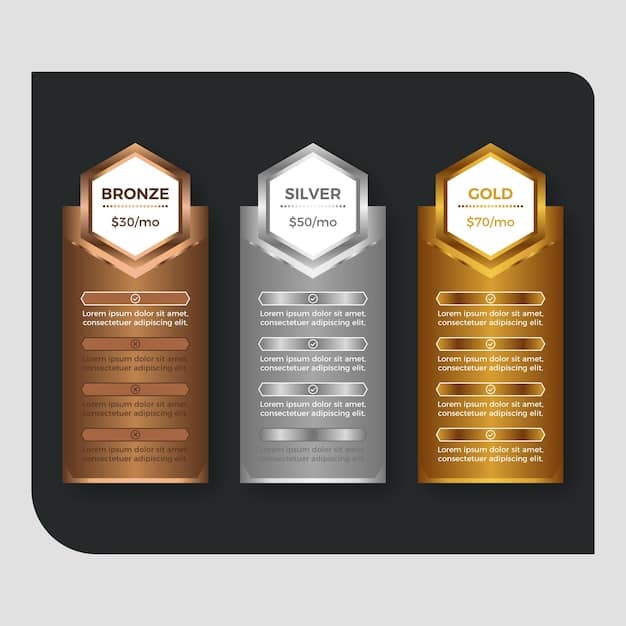Health Plan Tiers 2025: Find the Best Metal Level Value

Understanding health plan tiers, often categorized by metal levels (Bronze, Silver, Gold, and Platinum), is crucial for selecting a plan that balances monthly premiums with out-of-pocket costs, ensuring the best value for individual healthcare needs in 2025.
Navigating the complexities of health insurance can be daunting. **Understanding health plan tiers: which metal level offers the best value for you in 2025** is essential to making informed decisions. This guide breaks down each tier, helping you determine which one best suits your healthcare needs and budget.
Understanding Health Insurance Metal Tiers
Health insurance plans in the United States are often categorized into “metal tiers”: Bronze, Silver, Gold, and Platinum. Each tier represents a different balance between monthly premiums and out-of-pocket costs when you receive care. Knowing the ins and outs of each tier is a key step towards choosing a health plan that aligns with your personal and financial circumstances. This section aims to provide a clear overview.
The metal tiers were created by the Affordable Care Act (ACA) to help consumers easily compare health insurance options. The tier dictates how the plan and you will split the costs of your healthcare.
What are the Different Metal Tiers?
Each metal tier is designed to cover a certain percentage of your healthcare costs, on average. This doesn’t mean that every plan within a tier will cover exactly the same costs, but rather that the overall cost-sharing is similar.
- Bronze: This tier typically has the lowest monthly premiums but the highest out-of-pocket costs.
- Silver: Silver plans offer a moderate balance between premiums and out-of-pocket costs.
- Gold: Gold plans usually have higher premiums but lower out-of-pocket costs compared to Silver and Bronze.
- Platinum: Platinum plans have the highest premiums but the lowest out-of-pocket costs.

Choosing the right tier involves considering how much healthcare you anticipate needing in 2025 and how comfortable you are with higher monthly premiums versus larger out-of-pocket expenses.
Bronze Plans: Low Premiums, High Deductibles
Bronze plans often appeal to individuals seeking the lowest possible monthly premium. These plans are designed to protect you from catastrophic medical events, but they require you to pay more out-of-pocket for routine care.
Bronze plans are frequently chosen by younger, healthier individuals who don’t anticipate needing a lot of medical care throughout the year.
Who Should Consider a Bronze Plan?
Bronze plans typically have the lowest monthly premiums but the highest deductibles and out-of-pocket costs. This makes them a suitable option for:
- People who rarely need medical care beyond annual checkups.
- Individuals who are comfortable with higher out-of-pocket expenses if they do need care.
- Those primarily seeking coverage for major medical emergencies.
It’s crucial to understand the deductible, co-pays, and co-insurance associated with a Bronze plan. These costs will determine how much you pay for medical services before your insurance coverage kicks in.
Silver Plans: Balancing Cost and Coverage
Silver plans strike a balance between monthly premiums and out-of-pocket costs. They provide a moderate level of coverage and are a popular choice for many individuals and families.
Silver plans are the only metal tier eligible for cost-sharing reductions, which can significantly lower out-of-pocket costs for those who qualify based on income.
Cost-Sharing Reductions (CSRs) on Silver Plans
One of the most significant advantages of Silver plans is their eligibility for cost-sharing reductions (CSRs). These subsidies are available to individuals and families with incomes between 100% and 250% of the federal poverty level. CSRs can substantially lower your out-of-pocket costs such as deductibles, co-pays, and co-insurance.
Key features of Silver Plans:
- Moderate monthly premiums.
- Moderate out-of-pocket costs.
- Eligibility for cost-sharing reductions (CSRs) for qualifying individuals.
Silver plans offer a good balance for those who want predictable monthly costs without bearing the full burden of out-of-pocket expenses.
Gold Plans: Higher Premiums, Lower Out-of-Pocket Costs
Gold plans cater to those who prefer paying higher monthly premiums in exchange for lower out-of-pocket costs when they receive medical care. These plans are a good choice for individuals who anticipate needing frequent medical services.
Gold plans typically have lower deductibles, co-pays, and co-insurance compared to Bronze and Silver plans, meaning you’ll pay less each time you visit the doctor or fill a prescription.
Are Gold Plans Right for You?
Consider a Gold plan if:
- You frequently need medical care, such as doctor visits, physical therapy, or prescription medications.
- You prefer paying a higher monthly premium for greater cost predictability.
- You want to minimize out-of-pocket costs when you receive care.

While the monthly premiums are higher, the reduced out-of-pocket expenses can make Gold plans a cost-effective option for those who use healthcare services frequently.
Platinum Plans: Extensive Coverage, Highest Premiums
Platinum plans offer the most comprehensive coverage and the lowest out-of-pocket costs, but they also come with the highest monthly premiums. These plans are best suited for individuals with significant healthcare needs.
Platinum plans are designed to cover approximately 90% of your healthcare costs, on average, leaving you responsible for only 10%.
Who Benefits Most from Platinum Plans?
Platinum plans are an excellent choice for:
- Individuals with chronic conditions that require frequent medical care.
- People who prefer the predictability of very low out-of-pocket costs.
- Those who value comprehensive coverage and are willing to pay a higher monthly premium.
While Platinum plans provide the most extensive coverage, it’s essential to assess whether the higher premiums justify the benefits based on your individual healthcare needs.
Factors to Consider When Choosing a Tier
Choosing the right health plan tier involves carefully evaluating several factors, including your healthcare needs, budget, and risk tolerance. There’s no one-size-fits-all approach, so taking the time to consider your personal circumstances is crucial.
Consider all the factors, comparing the annual cost of health care between difference choices to determine the most benefical option.
Assessing Your Healthcare Needs
- Frequency of Doctor Visits: Do you visit the doctor frequently, or only for annual checkups?
- Prescription Medications: Do you take prescription medications regularly?
- Chronic Conditions: Do you have any chronic conditions that require ongoing care?
Budget Considerations
Your budget plays a significant role in determining which health plan tier is affordable. Consider how much you can comfortably afford to pay each month in premiums, as well as potential out-of-pocket expenses.
Risk Tolerance
Your risk tolerance reflects how comfortable you are with potentially high out-of-pocket expenses. If you’re risk-averse, you may prefer a plan with higher premiums but lower cost-sharing.
| Key Point | Brief Description |
|---|---|
| 💰 Bronze Plans | Lowest premiums, highest out-of-pocket costs; suited for healthy individuals. |
| ⚖️ Silver Plans | Balance premiums and costs; eligible for cost-sharing reductions. |
| ⭐ Gold Plans | Higher premiums, lower out-of-pocket costs; ideal for frequent care. |
| 💎 Platinum Plans | Highest premiums, lowest out-of-pocket costs; best for chronic conditions. |
Frequently Asked Questions
▼
The metal levels (Bronze, Silver, Gold, and Platinum) categorize health insurance plans based on how the plan and you share costs. They help you compare plans with different premium and out-of-pocket expense balances.
▼
Bronze plans typically have the lowest monthly premiums. However, they also have the highest deductibles and out-of-pocket costs when you need medical care.
▼
No, cost-sharing reductions (CSRs) are exclusively available for Silver plans. These subsidies lower your out-of-pocket costs if you meet certain income requirements.
▼
Platinum plans are often the best choice for individuals with chronic conditions. Although they have the highest premiums, they offer the lowest out-of-pocket costs.
▼
Consider your healthcare needs, budget, and risk tolerance. If you anticipate needing frequent care, a Gold or Platinum plan might be best. If you’re healthy and budget-conscious, a Bronze or Silver plan could be suitable.
Conclusion
Choosing the right health plan metal tier for 2025 involves carefully considering your healthcare needs, budget, and risk tolerance. Understanding the differences between Bronze, Silver, Gold, and Platinum plans will empower you to make an informed decision that provides the best value for your individual circumstances.





